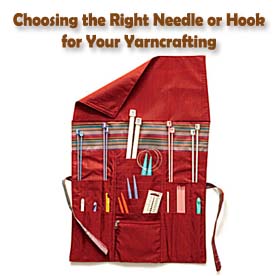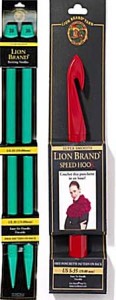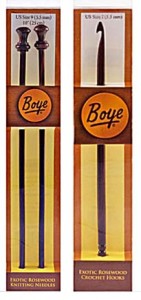 Just as there are many different variations of yarns, there are types of needles and hooks to choose from as well. Hooks and needles come in different shapes, sizes, and textures to help you achieve your best results when yarncrafting. They even come in fun colors and designs, allowing you to add a personal touch to your collection of supplies! Imagine your friend handing you a pair of needles in that royal purple color she knows you love so much; you’ll always remember that moment when you work with those needles.
Just as there are many different variations of yarns, there are types of needles and hooks to choose from as well. Hooks and needles come in different shapes, sizes, and textures to help you achieve your best results when yarncrafting. They even come in fun colors and designs, allowing you to add a personal touch to your collection of supplies! Imagine your friend handing you a pair of needles in that royal purple color she knows you love so much; you’ll always remember that moment when you work with those needles.
The most common materials you’ll find your needles or hooks in are plastic, wood and metal. Needle or hook choice is entirely up to you, but it might be beneficial for you to know that the different materials of the needles/hooks can affect the way your knitting or crochet may feel (and sound) as you work.
It’s good to consider having multiple needles and hooks in varying materials, because their properties may have different effects on your gauge. In other words, you may find that you get a slightly different gauge when you knit/crochet with bamboo compared to when you knit/crochet with metal. Read below for more info on how the different tool materials affect yarncrafting styles.
 |
Plastic needles/hooks are usually made of acrylic, and are lightweight. In terms of performance, they are a middle ground between wood and metal; they are smooth and not too slippery. Plastic needles have a pretty moderate grip, so they’re good for yarns with halos, such as Amazing, and yarns more prone to splitting. A great benefit to using plastic needles is their durability; they’re easier to work with for knitters’ who have repetitive stress injuries or arthritis. Because plastic is a light material, knitting with plastic needles will make little to no sound while working.
Click here for plastic knitting needles. |
 |
Wood needles/hooks come in different types of wood materials such as rosewood and bamboo. They are also smooth, and relatively light. Wood will have a stronger grip on your yarn, which helps prevent it from accidentally slipping off (great for beginners). It’s a good tool for yarns such as Martha Stewart CraftsTM/MC Extra Soft Wool Blend, and Nature’s Choice Organic, and makes for great double pointed needles (DPN). Wood needles/hooks are warm to the touch and splinter free; and it’s great for yarncrafters of all skill levels. Because they’re so light, wood needles are typically pretty quiet to work with, especially bamboo.
Click here for wood knitting needles, and click here for bamboo needles. |
 |
Metal needles/hooks are strong, durable and smooth, and are most commonly found in the aluminum form. Metals typically have a looser grip on yarns – allowing you to knit/crochet faster. Metal tools have a cool hand, and are a preferred choice for lace knitting, as their needles can come in small diameters and sharp heads. Since the metal is a heavier material, it may tend to make slight “clicking” sounds while knitting. Metal needles and hooks are great for yarns like Sock Ease.
Click here for metal knitting needles. |
Share with us, what kind of needles and hooks do you prefer? Do you prefer one type of material over another?
Related Links:
Meagan
I find sound/feel to be particularly noticeable in an aluminum hook-acrylic yarn combination. There’s no clicking (being one single hook), but I can actually hear the aluminum and acrylic rubbing together. This tends to go away within 5 minutes (maybe because the hook gets warmed up?) but it’s still a bit nails-on-a-chalkboard to me. I do love my plastic hooks and really need to get more. They’re light and smooth and great (I just feel bad about using them since I’m a bit anti-plastic in general). I’ve only just started working with wood hooks, since I invested in a knooking kit. Mine don’t seem to be well-made, as at least one of them has needed filing because of it catching the yarn, but in general I do like the feel of them for more slippery yarns.
Another thing to note is shape (at least for hooks; I’m not so knowledgeable in the needle department). I have both the flat-head hooks and the pointier ones. The flat work much better for splitty yarns and the pointy-ended ones are great for quick, lacey projects.
My husband may say I have too many hooks, but like you I find value in all of them. 🙂
Brandyce
Hi Meagan, thanks so much for sharing your experience with us. I understand the anti-plastic sentiment, but – think about how strong the hook is and how long it will last, you’ll definitely get a lot of use out of it. I didn’t go into shapes; but you’re absolutely right, the shape of the hook head (as well as needles, some are blunt tips and some are more sharp) can definitely affect how you yarncraft!
GailBresser
I have hooks and needle of all materials. Which type I use depends on the yarn. For circular knitting needles prefer metal because I want it to be easy to slip around the cord and needles ; also, I find metal needles are easier on my hands because the yarn slips easily, less manipulation. The clicking doesn’t bother me. For smaller crochet hooks I like to use metal because plastic hooks bend in smaller sizes. I have to say, what you use depends on the project and the yarn. I don’t care for bamboo needles because they are too grippy and the yarn has to be scooted up the needle. Everyone has their personal preference and new knitters/crocheters need to see what works best for them.
Brandyce
Thanks GailBresser, I agree, it just takes some time and practice for new yarncrafters to figure out what they prefer – but I like that you mentioned you prefer metal needles with circs for the easier movement along the cord, makes perfect sense 🙂
Teresa Tripicchio LaMorte
Thank you for so clearly laying it out. Â I use mainly metal, mainly because I do not want to pay the higher cost of wood. Â I also have some plastic, which date back from my early days in crochet, or if metal was not available for a particular hook size.
Toadmier15
For crochet, I almost always use metal, as it allows me the speed and smoothness I need, and I just like the feel. However, I do have a fun, colorful plastic set that I use when in government buildings, such as serving on Jury Duty (LOTS of waiting around – great time to work on a project!). Most government places will not allow the metal, but have no problem with the plastic. I’m just learning to knit and was recommended to use bamboo needles because they have better grip. I got discouraged so many times trying to learn on metal needles, but will probably make the transition as I get more confident in my knitting.
Ewilson
As for the metal needles “clicking”, I was knitting in my daughter’s hospital room at night waiting for my 2nd grandson’s arrival. She was turned on her side with her back to me and she asked if I was knitting-she could hear something clicking. I said yes I was, was it bothering her? I could stop if it was. She said no, its a comforting sound, to know I was there. And Baby Logan got a little present out of it, too!:)
Livingforjesus
I like the metal needles because they don’t break like the plastic ones. I haven’t really tried the wood needles. I also like the metal beacuse they click. I like the sound.
Dani
Please answer!!! Is it okay to change from a metal hook to a wooden hook in mid-project??? THIS IS IMPORTANT IM COMPETING IN A NATIONAL COMPETITION!!!!
Zoë Williams
Hi Dani. I don’t see why it wouldn’t be OK to change hooks, but you might want to check the regulations for the contest you’re participating in. Also, you should be aware that yarn slides slightly differently over wood than it does over metal, so you might experience a change in gauge when you switch.